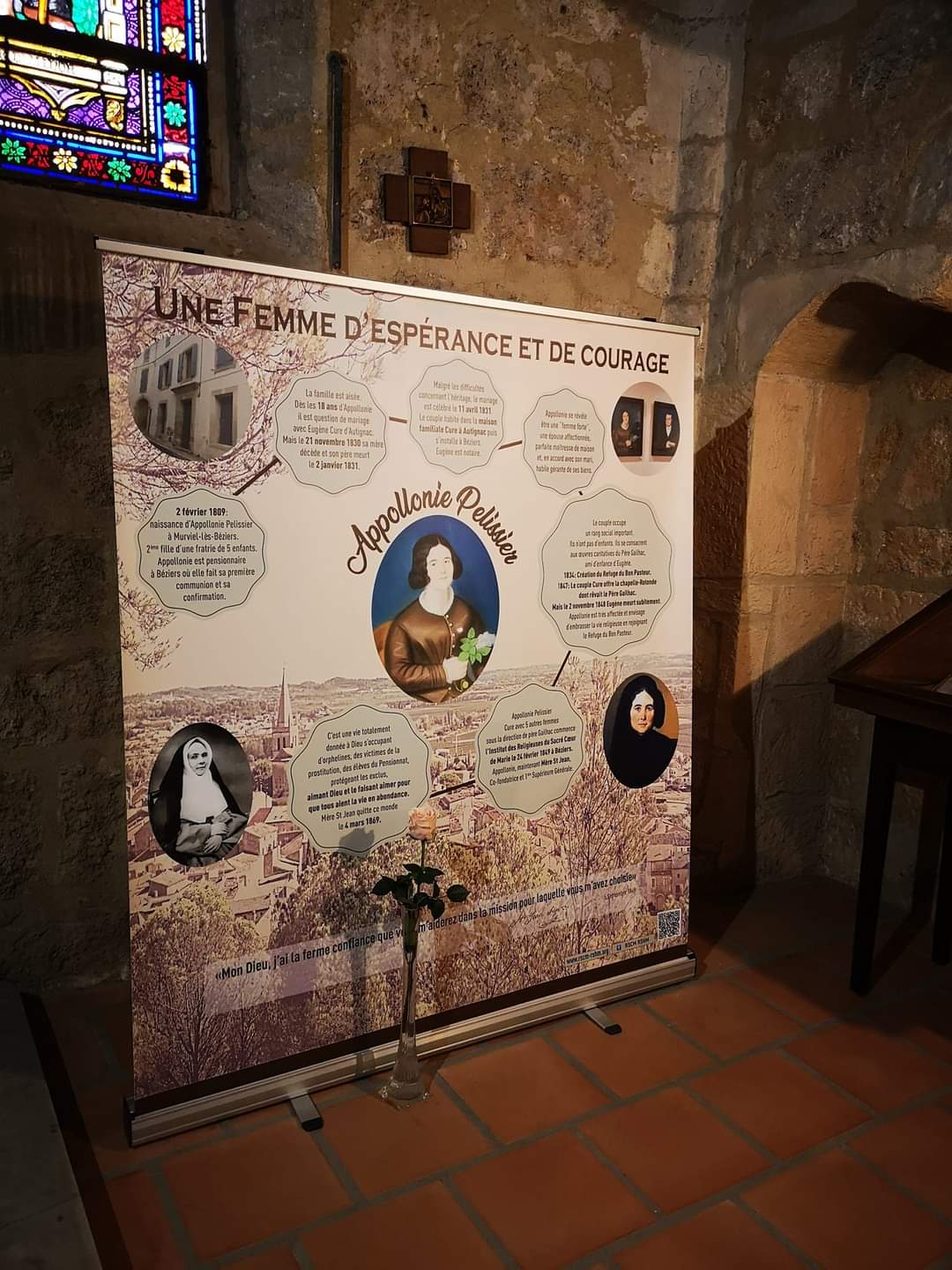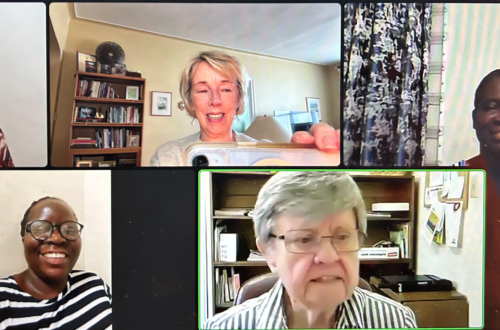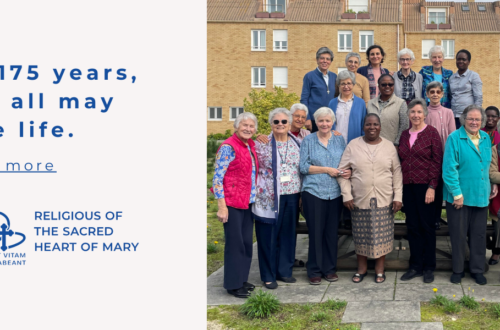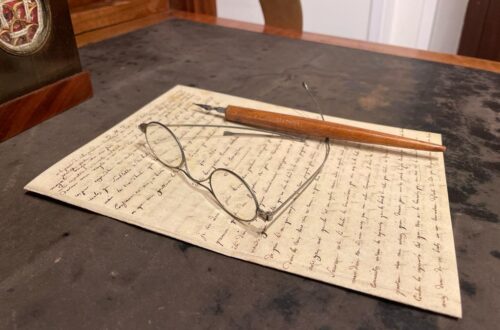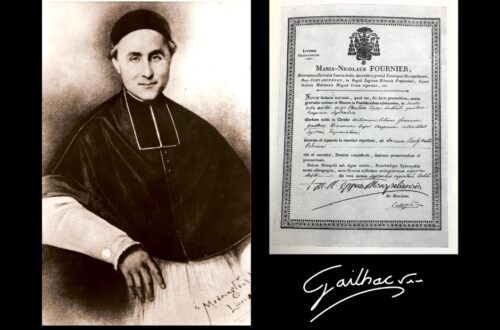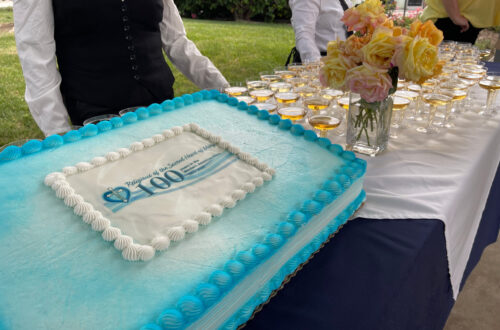Appollonie Cure Pélissier, Mère St Jean – fille de Murviel.
8/1/23
Heather Summers
Appollonie : who was she?
She was born in Murviel on 2 February 1809; she was baptised in this church 3 days later.
She was the youngest child in a rich family of landowners.
Where did she learn the values which led her to give up her wealthy middle class lifestyle to devote herself and her fortune to the care of former victims of prostitution and orphans and to the leadership of a community of sisters?
It was here, in the streets of Murviel.
According to tradition, it was from her mother’s example that she learned to care for the underprivileged. It was here that she learned to put into practice the virtues of justice and charity.
Her father and uncle were both mayors of Murviel. It was here that she imbibed the spirit of service which would one day lead to the foundation of an international congregation present on four continents.
But her compassion alone would not have fitted her for this achievement. Just as important was her character.
When she was about 18, she and her parents agreed that she would marry Eugène Cure, a lawyer from Autignac. But things did not turn out as expected. Quite suddenly, when she was 21, both parents died within seven weeks. A double bereavement.
Appollonie suddenly became a very rich woman. Her family tried to persuade her to break off the engagement. They even used threats of physical violence against Eugène to stop the marriage.
Imagine her shock and grief and the unacceptable pressure from her family. Girls in 1830 were not brought up to be assertive and stand their ground. But she found the strength to do what she believed was God’s call – to become Eugène’s wife.
Appollonie and Eugène were married in this church on 12 April 1831. For seventeen years, as Mme Cure, she was the mistress of an upper middle class household in Béziers and benefactress of P Gailhac’s project at Bon Pasteur.
But then history repeated itself. Eugène died unexpectedly. She was only 39 years old. And yet, within two months, she discerns the will of God calling her to join P Gailhac’s new congregation. She has no experience of the religious life and yet she decides to give up her comfortable home to share her life with women whose experience was far removed from her own. P Gailhac naturally asks her to wait.
This time it is P Gailhac’s decision she has to oppose. But again, she is single-minded in her determination and seeks the bishop’s permission, which she receives. P Gailhac has no choice but to accept her vocation. Overnight, she becomes responsible for 80 people: former prostitutes, orphans and novices.
She had never been a novice, but now she is a superior. She is Mère St Jean. She devotes her whole life and her wealth to Bon Pasteur.
For 20 years M St Jean was the superior and spiritual guide of an expanding community.
She directed the purchase of land and construction of new buildings resulting in the extensive complex we can still see today. The Institute consisted of five distinct sections: the Community, the Novitiate, the Preservation, the Orphanage and the Pensionnat.
This thriving institution, full of enthusiasm and resourcefulness, on the threshold of expansion throughout the world, was her legacy, her achievement.
For the last ten years of her life, M St Jean suffered serious digestive problems. At the end of 1868 her health declined sharply.
She died on 4 March 1869, aged 60.
I want to finish by quoting some of her own words.
“Nothing happens without God’s willing it. We must in all things submit to His holy will.”
I believe that as a very young woman Appollonie had learnt a secret of the spiritual life, referred to by an earlier age as ‘abandonment to divine providence’ in spite of a natural interior revolt: the acceptance that God will turn even the most seemingly disastrous events to our true interests. Whereshe thought something was asked of her, she finds a gift bestowed.
Or, if you prefer, St Paul, Romans 8,28: ‘All things work together for those who love God’.
This gives her a clarity of vision which automatically desires what she has perceived the will of God to be. To fight for this without deflection is a natural result of such clear sightedness.
This is how she succeeded in her vocation despite her lack of experience.
It is why she could take radical decisions so rapidly and stick to them.
It is how she achieved the expansion and solidity of the Institute in those first twenty years.
[Many of us here today have some debt of gratitude for the part Appollonie has played in our lives. Let us spend a few moments reflecting on our own relationship with her and her story before we go on to give thanks for her life. ]
